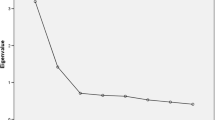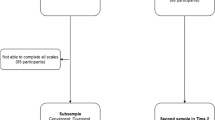Abstract
Purpose
The Epworth Sleepiness Scale (ESS) is a widely used tool for measuring sleepiness. In addition to providing a single measure of sleepiness (a one-factor structure), the ESS also has the capacity to provide additional information about specific factors that facilitate sleep onset, including a person’s posture, activity and environment. These features of sleepiness are referred to as somnificity. This study evaluates and compares the fit of a one-factor structure (sleepiness) and three-factor structure (reflecting low, medium and high levels of somnificity) for the ESS.
Methods
All participants (a community sample N = 356 and a clinical sample N = 679) were administered the ESS. Confirmatory factor analysis was used to evaluate and compare the fit of one- and three-factor models of the ESS.
Results
In both samples, a three-factor structure (community sample adjusted X 2 = 2.95, root mean square error of approximation (RMSEA) = 0.07, Comparative Fit Index (CFI) = 0.95; clinical sample adjusted X 2 = 3.98, RMSEA = 0.07, CFI = 0.98) provided a level of model fit that was at least as good as the one-factor structure (community sample adjusted X 2 = 5.01, RMSEA = 0.11, CFI = 0.87; clinical sample adjusted X 2 = 8.87, RMSEA = 0.11, CFI = 0.92).
Conclusions
In addition to a single measure of sleepiness, the ESS can provide subscale scores which relate to three underlying levels of somnificity. These findings suggest that the ESS can be used to measure an individual’s overall sleep propensity as well as more specific measures of sleep propensity in low, moderate and high levels of situational somnificity.


Similar content being viewed by others
References
Sauter C, Senbaum SA, Popvic R, Bauer H, Lamm C, Klosch G, Zeitlhofer J (2010) Excessive daytime sleepiness in patients suffering from different levels of obstructive sleep apnoea syndrome. J Sleep Res 9:293–301
Tsai JCG (2010) Neurological and neurobehavioural sequelae of obstructive sleep apnea. Neurorehabilitation 26:85–94
Webb W (1995) The cost of sleep-related accidents: a reanalysis. Sleep 18:276–280
Lyznicki JM, Doege TC, Davis RM, Williams MA (1998) Sleepiness, driving and motor vehicle crashes. J Am Med Assoc 279:1908–1913
Takegami M, Morita S, Chin K, Akashiba T, Kimura H, Suzukamo Y, Fukuhara S (2011) Impact of excessive daytime sleepiness on health-related quality of life in patients with obstructive sleep apnea syndrome. Qual Life Res 13:1555
Johns MW (1991) A new method for measuring daytime sleepiness: the Epworth sleepiness scale. Sleep 14:540–545
Johns MW (2002) Sleep propensity varies with behaviour and the situation in which it is measured: the concept of somnificity. J of Sleep Res 11:61–67
Izci B, Ardic S, Firat H, Sahin A, Altinors M, Karacan I (2008) Reliability and validity studies of the Turkish version of the Epworth Sleepiness Scale. Sleep Breath 12:161–168
Chen N-H, Johns MW, Li H-Y, Chu C-C, Liang S-C, Shu Y-H, Chuang M-L, Wang P-C (2002) Validation of a Chinese version of the Epworth sleepiness scale. Qual Life Res 11:817–821
Bloch KE, Schoch OD, Zhang JN, Russi EW (1999) German version of the Epworth Sleepiness Scale. Respiration 66:440–447
Shahid A, Shen J, Shapiro C (2010) Measurements of sleepiness and fatigue. J Psychom Res 69:81–89
Johns MW (1994) Sleepiness in different situations measured by the Epworth Sleepiness Scale. Sleep 17:703–710
MacCallum RC, Austin JT (2010) Applications of structural equation modelling in psychology research. Annu Rev Psychol 51:201–226
Iaccobucci D (2010) Structural equation modelling: fit indices, sample size, and advanced topics. J Consum Psychol 20:90–98
Byrne BM (2010) Structural equation modelling with AMOS: basic concepts, application and programming, 2nd edn. Taylor Francis Group, New York
Floyd FJ, Widaman KF (1995) Factor analysis in the development and refinement of clinical assessment instruments. Psychol Assess 7:286–299
Heaton K, Anderson D (2007) A psychometric evaluation of the Epworth Sleepiness Scale. J Nurs Meas 15:177–188
Johns MW (1992) Reliability and factor analysis of the Epworth Sleepiness Scale. Sleep 15:376–381
Kingshott RN, Engleman HM, Deary IJ, Douglas NJ (1998) Does arousal frequency predict daytime function? Eur Resp J 12:1264–1270
Smith SS, Oei TPS, Douglas JA, Brown I, Jorgensen G, Andrews J (2008) Confirmatory factor analysis of the Epworth Sleepiness Scale (ESS) in patients with obstructive sleep apnoea. J Sleep Med 9:739–744
Johns M, Hocking B (1997) Daytime sleepiness and sleep habits of Australian workers. Sleep 10:844–849
SPSS Inc (2009) SPSS for Windows, Rel. 18.0.0. SPSS Inc, Chicago
Arbuckle JL (2009) Amos 18.0, Version 2.0. SPSS Inc, Chicago
Hu L, Bentler PM (1999) Cutoff criteria for fit indexes in covariance structure analysis: conventional criteria versus new alternatives. Struct Equ Model 6:1–55
Kline RB (2004) Beyond significance testing. American Psychological Association, Washington, DC
Perlis ML, Jungquist C, Smith M, Posner D (2005) Cognitive behavioural treatment of insomnia: a session-by-session guide. Springer, New York
Fabrigar LR, Wegener DT, MacCallum RC, Strahan EJ (1999) Evaluating the use of exploratory factor analysis in psychological research. Psychol Methods 4:272–299
Green SB, Lissitz RW, Mulaik SA (1977) Limitations of coefficient alpha as an index of test unidimensionality. Educ Psychol Meas 37:827–838
Acknowledgments
This study would not have been possible without the essential and gracious support of many individuals: Professor David Hillman, Christine Maguire and the sleep technologists of Sir Charles Gairdner Hospital, as well as the students of the University of Western Australia, Tamara De Regt, Alisa Holt, Anna Wallace, Stephanie Whitworth, Alix Mellor, Andrew Nienaber, Jacinta Hatton and Shraddha Kashyup.
Author information
Authors and Affiliations
Corresponding author
Additional information
The work was conducted at the School of Psychology, University of Western Australia, Perth, Australia and Western Australian Sleep Disorders Research Institute, Sir Charles Gairdner Hospital, Perth, Western Australia, Australia.
Electronic supplementary material
Below is the link to the electronic supplementary material.
ESM 1
DOC 42 kb
Rights and permissions
About this article
Cite this article
Olaithe, M., Skinner, T.C., Clarke, J. et al. Can we get more from the Epworth Sleepiness Scale (ESS) than just a single score?. Sleep Breath 17, 763–769 (2013). https://doi.org/10.1007/s11325-012-0763-6
Received:
Revised:
Accepted:
Published:
Issue Date:
DOI: https://doi.org/10.1007/s11325-012-0763-6




